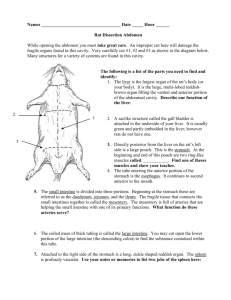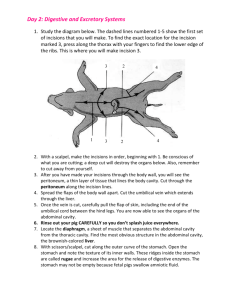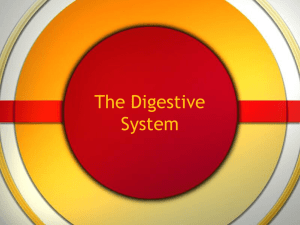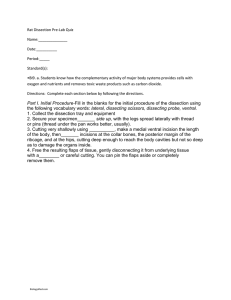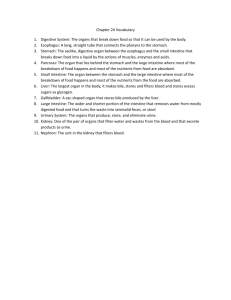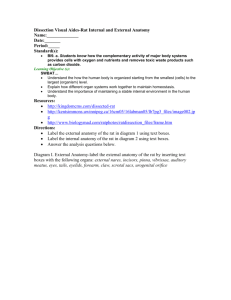Rat Dissection: External Anatomy ... Make sure you know the locations and functions of all...
advertisement
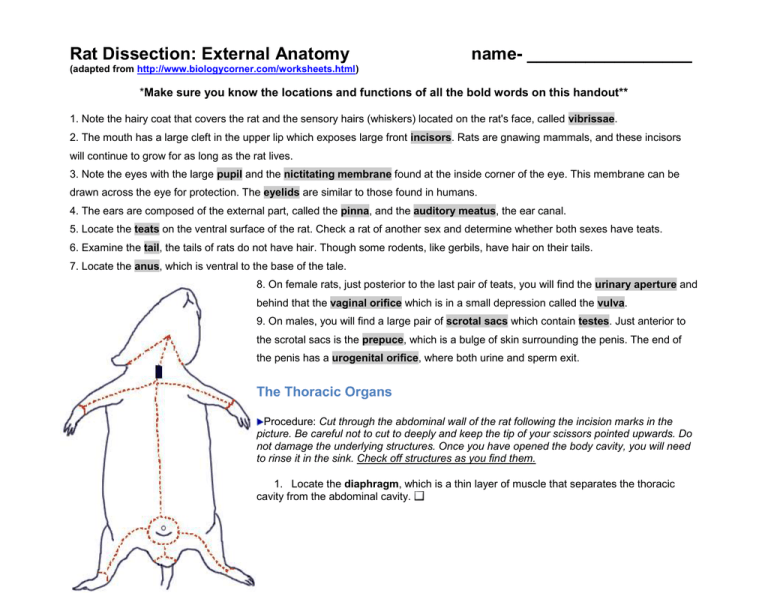
Rat Dissection: External Anatomy name- _________________ (adapted from http://www.biologycorner.com/worksheets.html) *Make sure you know the locations and functions of all the bold words on this handout** 1. Note the hairy coat that covers the rat and the sensory hairs (whiskers) located on the rat's face, called vibrissae. 2. The mouth has a large cleft in the upper lip which exposes large front incisors. Rats are gnawing mammals, and these incisors will continue to grow for as long as the rat lives. 3. Note the eyes with the large pupil and the nictitating membrane found at the inside corner of the eye. This membrane can be drawn across the eye for protection. The eyelids are similar to those found in humans. 4. The ears are composed of the external part, called the pinna, and the auditory meatus, the ear canal. 5. Locate the teats on the ventral surface of the rat. Check a rat of another sex and determine whether both sexes have teats. 6. Examine the tail, the tails of rats do not have hair. Though some rodents, like gerbils, have hair on their tails. 7. Locate the anus, which is ventral to the base of the tale. 8. On female rats, just posterior to the last pair of teats, you will find the urinary aperture and behind that the vaginal orifice which is in a small depression called the vulva. 9. On males, you will find a large pair of scrotal sacs which contain testes. Just anterior to the scrotal sacs is the prepuce, which is a bulge of skin surrounding the penis. The end of the penis has a urogenital orifice, where both urine and sperm exit. The Thoracic Organs Procedure: Cut through the abdominal wall of the rat following the incision marks in the picture. Be careful not to cut to deeply and keep the tip of your scissors pointed upwards. Do not damage the underlying structures. Once you have opened the body cavity, you will need to rinse it in the sink. Check off structures as you find them. 1. Locate the diaphragm, which is a thin layer of muscle that separates the thoracic cavity from the abdominal cavity. 2. The heart is centrally located in the thoracic cavity. The two dark colored chambers at the top are the atria (single: atrium), and the bottom chambers are the ventricles. The heart is covered by a thin membrane called the pericardium. 3. Locate the thymus gland, which lies directly over the upper part of the heart. The thymus functions in the development of the immune system and is much larger in young rats than it is in older rats. 4. The lungs are spongy organs that lie on either side of the heart and should take up most of the thoracic cavity. The Abdominal Organs 1. The coelom is the body cavity within which the viscera (internal organs) are located. The cavity is covered by a membrane called the peritoneum, which is very thin and web-like, you may need to use forceps to remove some of this membrane to see the organs clearly. 2. Locate the liver, which is a dark colored organ suspended just under the diaphragm. The liver has many functions, one of which is to produce bile, which aids in digesting fat. The liver also transforms wastes into less harmful substances. Rats do not have a gall bladder, which is used for storing bile in other animals. There are four parts to the liver: 3. The esophagus pierces the diaphragm and moves food from the mouth to the stomach. It is easiest to locate where it enters the stomach. 4. Locate the stomach on the left side just under the diaphragm. The functions of the stomach include food storage, physical breakdown of food, and the digestion of protein. You can make a slit in the stomach and see what is inside it. Most of the contents should be partly digested rat food. At each end of the stomach (on the inside) is muscular valve. The opening between the esophagus and the stomach is called the cardiac sphincter. The opening between the stomach and the intestine is called the pyloric sphincter. 5. The spleen is about the same color as the liver and is attached to the greater curvature of the stomach. It is associated with the circulatory system and functions in the destruction of blood cells and blood storage. A person can live without a spleen, but they're more likely to get sick as it helps the immune system function. 6. The pancreas is a brownish, flattened gland found in the tissue between the stomach and small intestine. The pancreas produces digestive enzymes that are sent to the intestine via small ducts (the pancreatic duct). The pancreas also secretes insulin, which is important in the regulation of glucose metabolism. 7. The small intestine is a slender coiled tube that receives partially digested food from the stomach (via the pyloric sphincter). It consists of three sections: duodenum, jejunum and ileum, (Listed in order from the stomach to the large intestine.) The duodenum is recognizable as the first stretch of the intestine leading from the stomach, it is mostly straight. The jejunum and ileum are both curly parts of the intestine, with the ileum being the last section before the small intestine becomes the large intestine. 8. Locate the colon, which is the large greenish tube that extends from the small intestine and leads to the anus. The colon is also known as the large intestine. Food entering the colon from the small intestine is controlled by the ileocecal valve. The colon is where the finals stages of digestion and water absorption occurs and it contains a variety of bacteria to aid in digestion. Urogenital System The excretory and reproductive systems of vertebrates are closely integrated and are usually studied together as the urogenital system. However, they do have different functions: the excretory system removes wastes and the reproductive system produces gametes (sperm & eggs). The reproductive system also provides an environment for the developing embryo and regulates hormones related to sexual development. Excretory Organs 1. The primary organs of the excretory system are the kidneys. These organs are large bean shaped structures located toward the back of the abdominal cavity on either side of the spine. Renal arteries and veins supply the kidneys with blood. 2. Locate the delicate ureters that attach to the kidney and lead to the bladder. Wiggle the kidneys to help locate these tiny tubes. 3. The urethra carries urine from the bladder to the urethral orifice (this orifice is found in different areas depending on whether you have a male or female rat). 4. The small yellowish glands embedded in the fat atop the kidneys are the adrenal glands. The Reproductive Organs of the Male Rat 1. The major reproductive organs of the male rat are the testes (singular: testis) which are located in the scrotal sac. Cut through the sac carefully to reveal the testis. On the surface of the testis is a coiled tube called the epididymus, which collects and stores sperm cells. The tubular vas deferens moves sperm from the epididymus to the urethra, which carries sperm though the penis and out the body. 2. The lumpy brown glands located to the left and right of the urinary bladder are the seminal vesicles. The gland below the bladder is the prostate gland and it is partially wrapped around the penis. The seminal vesicles and the prostate gland secrete materials that form the seminal fluid (semen). The Reproductive Organs of the Female Rat 1. The short gray tube lying dorsal to the urinary bladder is the vagina. The vagina divides into two uterine horns that extend toward the kidneys. This duplex uterus is common in some animals and will accommodate multiple embryos (a litter). In contrast, a simple uterus, like the kind found in humans has a single chamber for the development of a single embryo. 2. At the tips of the uterine horns are small lumpy glands called ovaries, which are connected to the uterine horns via oviducts. Oviducts are extremely tiny and may be difficult to find without a dissecting scope. 3. The urethra carries urine from the bladder to the urethral orifice (this orifice is found in different areas depending on whether you have a male or female rat). . Rat - Circulatory System 1. Blood from the posterior portion of the body enters the right atrium of the heart through the inferior vena cava. The inferior vena cava is also referred to as the caudal vena cava. 2. Blood from the anterior parts of the rat enter the heart from the right and left superior vena cava, also known as the cranial vena cava. 3. Blood flows from the right atrium to the right ventricle via the tricuspid valve. 4. Blood is then pumped through the pulmonary semilunar valve and into the pulmonary trunk, which divides into the left and right pulmonary arteries - these are the only arteries in the body that carry deoxygenated blood. 5. Blood then flows through the pulmonary arteries to the lungs where it is oxygenated and then returns from the lungs to enter the left atrium via four pulmonary veins. 5. Blood goes from the left atrium to the left ventricle via the biscupid (or mitral) valve. 6. Blood leaves the left ventricle of the heart through the aortic semilunar valve and enters the aorta. 7. Coronary arteries are located on top of the heart and supply the heart itself with blood. 8. The first visible branch from the aorta is the brachiocephalic artery, it divides into the right common carotid artery, which supplies the right side of the neck, and the right subclavian artery, which supplies the right shoulder and arms. 9. At the most anterior part of the bend in the aortic arch is the left common carotid artery, which supplies blood up the left side of the neck. Immediately to the left of the left common carotid artery is the left subclavian artery, which supplies blood to the left shoulder and arm. *note that the branches are not symmetrical. 3. The right common carotoid passes along the neck toward the head where it gives rise to the right external carotid artery and the right internal carotid artery. 4. Similarly, the left common carotid can be traced toward the head where it branches into the left external cartoid artery and the left internal carotid artery. 5. The renal arteries are short and lead directly to the kidneys. 6. The inferior mesenteric artery leads to the intestinal mesenteries. 7. The abdominal aorta finally divides to form the iliac arteries, which deliver blood to the pelvis and hind legs. 8. The iliac arteries lead to the femoral artery in the leg. The Hepatic Portal System A portal system is a system of veins that carries blood from one bed of capillaries to another bed of capillaries. The hepatic portal system carries blood from the mesenteries, small intestine, spleen, stomach and pancreas to the liver. Specifically, the gastic, splenic, and mesenteric veins drain the digestive system and unit to form the hepatic portal vein which carries the blood to the liver. The liver is strategically located to receive blood after nutrients have been absorbed in the intestinal tract. The liver cells can easily modify these nutrients and remove toxins. The vessels of the hepatic portal system may be difficult to find. *Make sure you know the locations and functions of all the bold words on this handout**

